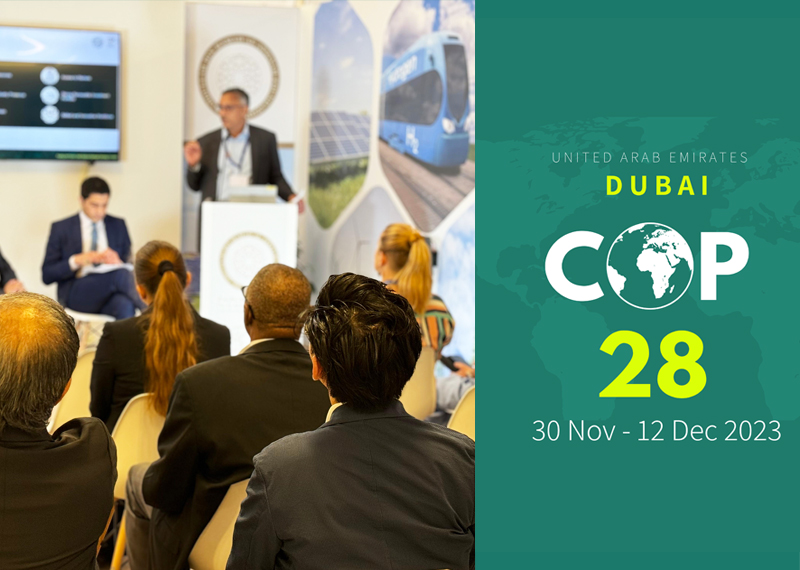Charting a Green Horizon After COP28: MENA Region Emerging as a Key Player in the Sustainable Energy Landscape
23 January 2024The Middle East and North Africa (MENA) is set to play a pivotal role in the energy transition as more than 130 countries agree to triple renewable energy capacity by 2030 at the 2023 United Nations Climate Change Conference or Conference of the Parties of the UNFCCC, more commonly known as COP28.
With 100,000 attendees, COP28 was the largest UNFCCC meeting to date. Held at the sprawling World Expo site in Dubai, it ended with significant achievements but also saw unexpected failures regarding important topics. It formally launched the operationalisation of the historic Loss and Damage (L&D) Fund with funding pledges of about USD 0.7 billion and adopted the Global Stocktake (GST) decision that includes a groundbreaking language regarding the weaning off fossil fuels.
However, COP28 also suffered setbacks, notably the deferral of crucial international carbon market agenda items under Article 6 and several adaptation-related topics, such as inability to take decisions on National Adaptation Plans and the Adaptation Committee report.
Alongside the formal negotiations, the conference saw the launch of several side deals and initiatives such as the Global Renewables and Energy Efficiency Pledge that seeks to triple the world’s green energy capacity to 11,000 GW in the next six years, thereby, reducing the reliance on fossil fuels in generating energy.
According to the pledge, countries will “double the global average annual rate of energy efficiency improvements from around 2% to over 4% every year until 2030”. By checking the rise in emissions, governments hope to curtail global average temperature below the 2-degree Celsius temperature limit since pre-industrial times, if not the ambitious 1.5 degree Celsius of the 2015 Paris Agreement.
The MENA region's abundant renewable resources position it as a potential major supplier of green energy and carbon credits. Technologies such as solar power, hydrogen, carbon capture, utilisation, and storage (CCUS), and direct air capture (DAC) are being actively implemented and explored by countries like Qatar, Saudi Arabia, the UAE, Oman, Egypt, and Morocco.
Qatar has made a promising start to its efforts to become a major player in the emerging hydrogen economy. In 2022, QatarEnergy unveiled plans for the world’s largest blue ammonia plant. Ammonia is a hydrogen carrier that can be stored as a liquid at relatively milder conditions than hydrogen, reducing the complexity and costs associated with handling and storage, making transportation feasible over long distances. In the same year, Doha demonstrated its commitment to solar energy by bringing its Al Kharsaah Solar PV project online, the country’s first large-scale solar venture. Qatar also plans to add two more solar plants with a combined capacity of 880 MW in the next two years, which potentially open doors for green hydrogen and ammonia production.[1]
Elsewhere, Saudi Arabia’s Dumat Al Jandal Wind Power Plant boasts 99 turbines that generate 400 MW and provides carbon-free electricity for 70,000 homes. The plant supports Saudi Arabia’s climate goals, reducing nearly 1 million tons of CO2 annually. Construction began in September 2019 and has been connected to the grid since 2021.
Despite such strong renewable energy commitments from the Middle East and the wider region, the viability of the pledge is dependent on substantial and immediate funding for such projects from industry and government across the world.
According to analysts at the BloombergNEF, meeting the target would require a doubling of the rate of investment in renewable energy to an average of $1,175 billion per year between 2023 and 2030, from $564 billion in 2022. It also requires power grid investment to rise to $777 billion in 2030, nearly three times as much as was spent on grids in 2022, and deploying 720 gigawatts of batteries worldwide by 2030, which is 16.1 times the total deployed at the end of 2022.[2]
The importance of renewable energy in the race to net-zero was highlighted by industry leaders and global experts during impactful dialogue sessions and presentations at the Al-Attiyah Foundation pavilion at COP28. They can be viewed on YouTube @AlAttiyahFoundation.
And for more information on the MENA region’s role in the energy transition, the Al-Attiyah Foundation’s latest Sustainability Research paper, titled ‘COP28 Unpacked: Assessing Outcomes and Shaping the Climate Policy Agenda’, can be accessed on https://www.abhafoundation.org/
[1] https://www.middleeastmonitor.com/20231128-qatars-path-in-the-global-hydrogen-economy/
[2] https://assets.bbhub.io/professional/sites/24/BNEF_2023-11-21_triplingrenewables_Final.pdf
